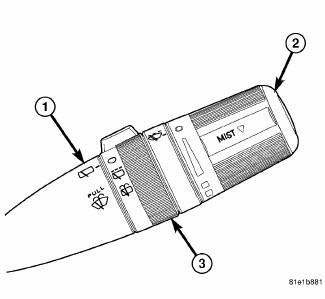Dodge Journey: Fluid, differential
Standard Procedure
STANDARD PROCEDURE - DIFFERENTIAL ASSEMBLY FLUID CHANGE

Fig. 79: Differential Assembly Fluid Change
The drain plug (2) for the differential assembly is located in the bottom of the differential assembly case, toward the rear of the unit.
The fill plug (3) for the differential assembly is located on the left side of the assembly case.
The correct fill level is to the bottom of the fill plug hole. Be sure the vehicle is on a level surface, or is hoisted in a level manner, in order to obtain the correct fill level.
1. Raise the vehicle on a hoist.
2. Position a drain pan under the differential drain plug.
3. Remove the drain plug and allow the fluid to drain into the pan.
4. Install the drain plug and torque to 35 N.m (26 ft. lbs.).
5. Re-position the drain pan under the differential fill plug.
6. Remove the differential fill plug.
7. Using a suction gun or equivalent, fill the differential assembly with 0.7 L (0.74 Quarts) of Mopar Gear and Axle Lubricant (75W-90).
8. Install the fill plug and torque to 35 N.m (26 ft. lbs.).
 Case assembly, differential
Case assembly, differential
DESCRIPTION
The differential gear system divides the torque between the axle shafts. It
allows the axle shafts to rotate at
different speeds when turning corners.
Each differential side gear is s ...
 Seal, input flange
Seal, input flange
REMOVAL
Fig. 80: Removing /Installing Propeller Shaft
NOTE: Rubber coupler is part of the propeller shaft assembly. Removing
coupler from
propeller shaft will result in vibration/balance i ...
See also:
Switch, horn
REMOVAL
WARNING: On vehicles equipped with an airbag, refer to Restraint
SERVICE
INFORMATION article for warnings and cautions before servicing the horn
switch.
Fig. 3: Remov ...
BRAKE SYSTEM
Your vehicle is equipped with dual hydraulic
brake systems. If either of the two hydraulic
systems loses normal capability, the remaining
system will still function. However, there will
be some ...
Removal, Installation
REMOVAL
REMOVAL - NGC CONTROLLER
Fig. 39: Remove/Install PCM
NOTE: USE THE SCAN TOOL TO REPROGRAM THE NEW POWERTRAIN CONTROL
MODULE (PCM) WITH THE VEHICLES ORIGINAL IDENTIFICATION NUMBER
( ...
